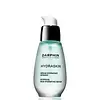What's inside
What's inside
 Key Ingredients
Key Ingredients

 Benefits
Benefits

 Concerns
Concerns

 Ingredients Side-by-side
Ingredients Side-by-side

Water
Skin ConditioningPropanediol
SolventGlycerin
HumectantButylene Glycol
HumectantMethyl Gluceth-20
HumectantPEG-40 Hydrogenated Castor Oil
EmulsifyingImperata Cylindrica Root Extract
Skin ConditioningPunica Granatum Extract
AstringentMalachite Extract
AntioxidantSodium Hyaluronate
HumectantTocopherol
AntioxidantEthylhexylglycerin
Skin ConditioningHyaluronic Acid
HumectantTrehalose
HumectantCaprylyl Glycol
EmollientSodium PCA
HumectantSodium Polyacrylate
Absorbent1,2-Hexanediol
Skin ConditioningPolyquaternium-51
Skin ConditioningUrea
BufferingCarbomer
Emulsion StabilisingSodium Carbomer
Emulsion StabilisingParfum
MaskingButylphenyl Methylpropional
PerfumingHydroxyisohexyl 3-Cyclohexene Carboxaldehyde
MaskingHexyl Cinnamal
PerfumingAlpha-Isomethyl Ionone
PerfumingLimonene
PerfumingLinalool
PerfumingHydroxycitronellal
PerfumingTetrasodium EDTA
Phenoxyethanol
PreservativeChlorphenesin
AntimicrobialPotassium Sorbate
PreservativeCI 42090
Cosmetic ColorantWater, Propanediol, Glycerin, Butylene Glycol, Methyl Gluceth-20, PEG-40 Hydrogenated Castor Oil, Imperata Cylindrica Root Extract, Punica Granatum Extract, Malachite Extract, Sodium Hyaluronate, Tocopherol, Ethylhexylglycerin, Hyaluronic Acid, Trehalose, Caprylyl Glycol, Sodium PCA, Sodium Polyacrylate, 1,2-Hexanediol, Polyquaternium-51, Urea, Carbomer, Sodium Carbomer, Parfum, Butylphenyl Methylpropional, Hydroxyisohexyl 3-Cyclohexene Carboxaldehyde, Hexyl Cinnamal, Alpha-Isomethyl Ionone, Limonene, Linalool, Hydroxycitronellal, Tetrasodium EDTA, Phenoxyethanol, Chlorphenesin, Potassium Sorbate, CI 42090
Water
Skin ConditioningGlycerin
HumectantDimethicone
EmollientIsodecyl Neopentanoate
EmollientAlcohol Denat.
AntimicrobialSaccharide Isomerate
HumectantPanthenol
Skin ConditioningTocopheryl Acetate
AntioxidantLeontopodium Alpinum Extract
Skin ConditioningMentha Aquatica Extract
TonicIris Ensata Extract
Skin ConditioningFaex Extract
Skin ConditioningMalt Extract
Skin ProtectingAdenosine
Skin ConditioningViola Tricolor Extract
EmollientCryptomeria Japonica Bud Extract
Skin ConditioningHydrolyzed Ceratonia Siliqua Gum Extract
Lavandula Angustifolia Oil
MaskingThymus Mastichina Flower Oil
Skin ConditioningSalvia Officinalis Oil
MaskingEDTA
Polysorbate 60
EmulsifyingSorbitan Isostearate
EmulsifyingSodium Citrate
BufferingSodium Benzoate
MaskingLinalool
PerfumingLimonene
PerfumingGeraniol
PerfumingWater, Glycerin, Dimethicone, Isodecyl Neopentanoate, Alcohol Denat., Saccharide Isomerate, Panthenol, Tocopheryl Acetate, Leontopodium Alpinum Extract, Mentha Aquatica Extract, Iris Ensata Extract, Faex Extract, Malt Extract, Adenosine, Viola Tricolor Extract, Cryptomeria Japonica Bud Extract, Hydrolyzed Ceratonia Siliqua Gum Extract, Lavandula Angustifolia Oil, Thymus Mastichina Flower Oil, Salvia Officinalis Oil, EDTA, Polysorbate 60, Sorbitan Isostearate, Sodium Citrate, Sodium Benzoate, Linalool, Limonene, Geraniol
Ingredients Explained
These ingredients are found in both products.
Ingredients higher up in an ingredient list are typically present in a larger amount.
Glycerin is already naturally found in your skin. It helps moisturize and protect your skin.
A study from 2016 found glycerin to be more effective as a humectant than AHAs and hyaluronic acid.
As a humectant, it helps the skin stay hydrated by pulling moisture to your skin. The low molecular weight of glycerin allows it to pull moisture into the deeper layers of your skin.
Hydrated skin improves your skin barrier; Your skin barrier helps protect against irritants and bacteria.
Glycerin has also been found to have antimicrobial and antiviral properties. Due to these properties, glycerin is often used in wound and burn treatments.
In cosmetics, glycerin is usually derived from plants such as soybean or palm. However, it can also be sourced from animals, such as tallow or animal fat.
This ingredient is organic, colorless, odorless, and non-toxic.
Glycerin is the name for this ingredient in American English. British English uses Glycerol/Glycerine.
Learn more about GlycerinLimonene is a fragrance that adds scent and taste to a formulation.
It's found in the peel oil of citrus fruits and other plants such as lavender and eucalyptus. The scent of limonene is generally described as "sweet citrus".
Limonene acts as an antioxidant, meaning it helps neutralize free radicals.
When exposed to air, oxidized limonene may sensitize the skin. Because of this, limonene is often avoided by people with sensitive skin.
The term 'fragrance' is not regulated in many countries. In many cases, it is up to the brand to define this term. For instance, many brands choose to label themselves as "fragrance-free" because they are not using synthetic fragrances. However, their products may still contain ingredients such as essential oils that are considered a fragrance.
Learn more about LimoneneLinalool is a fragrance and helps add scent to products. It's derived from common plants such as cinnamon, mint, citrus, and lavender.
Like Limonene, this ingredient oxidizes when exposed to air. Oxidized linalool can cause allergies and skin sensitivity.
This ingredient has a scent that is floral, spicy tropical, and citrus-like.
Learn more about LinaloolWater. It's the most common cosmetic ingredient of all. You'll usually see it at the top of ingredient lists, meaning that it makes up the largest part of the product.
So why is it so popular? Water most often acts as a solvent - this means that it helps dissolve other ingredients into the formulation.
You'll also recognize water as that liquid we all need to stay alive. If you see this, drink a glass of water. Stay hydrated!
Learn more about Water